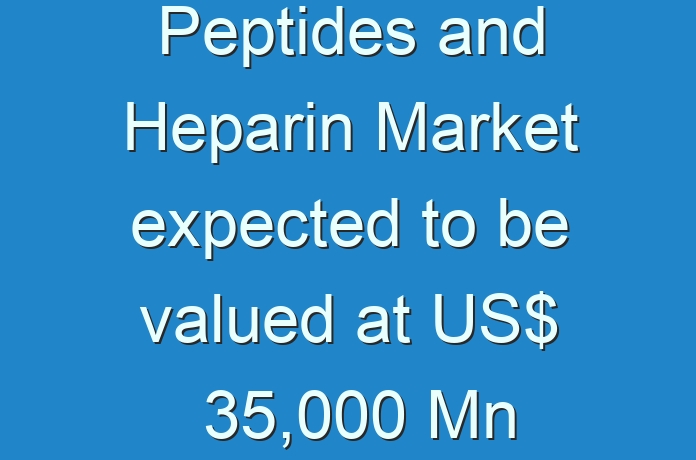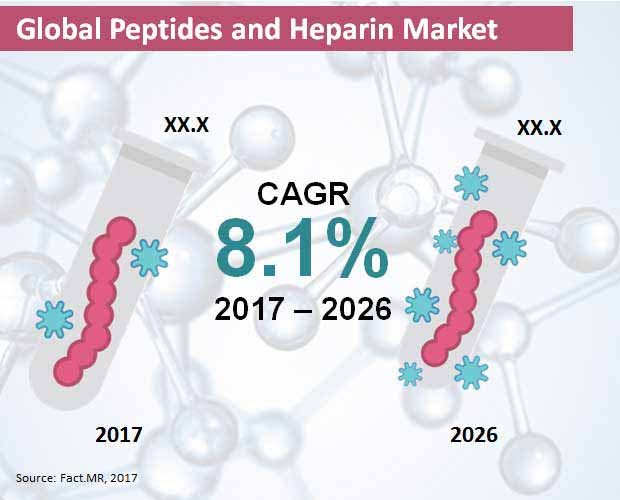
According to Fact.MR, the global peptide and heparin market is projected to reflect a high single-digit CAGR throughout the forecast period (2017-2026). The peptide and heparin market is estimated to reach nearly US$ 35,000 Mn revenues by 2026-end.
Click HERE To Get A SAMPLE (Including Full TOC, Table & Figures) At- https://www.factmr.com/connectus/sample?flag=S&rep_id=378

Vendors of Peptide Therapeutics are Outsourcing Manufacturing Processes to Developing Countries
Although therapeutic peptides were originally developed for replacing their endogenous lack, spectrum of the candidate peptide drugs available is not by far restrained to human peptide pool. With the help of multifarious organisms, bioactive peptides are being discovered through modern tools of peptidomics. A virtually infinite range of potential peptide-based medications await pharmacological characterization. Meanwhile, several methods of peptide synthesis are evolving to enable highly efficient production of extraordinarily long & heavily-modified compounds. Numerous clinical trials associated with peptide drug candidates are currently being conducted, which in turn represents a bright future for peptide-based therapeutics. Vendors of peptide therapeutics have been moving to developing countries on the back of large population base serving as potential clinical subjects. Lenient regulatory guidelines, skilled labor, low manufacturing costs, and low market competition are primary reasons why vendors of peptide therapeutics are outsourcing their manufacturing processes to these countries.
Need More Information About Report Methodology? Click Here- https://www.factmr.com/connectus/sample?flag=RM&rep_id=378
The market for heparin will continue to be influenced by increasing prevalence of diseases, which lead to formation of clots. Concerns regarding adulteration had been the cause for the prohibition of bovine heparin by the U.S. FDA. However, extreme shortage of porcine heparin has led the FDA to reconsider introduction of bovine heparin, which in turn has led to a rise in amount of crude heparin. Heparin is increasingly used prior to surgeries, during blood transfusion or dialysis, when blood is collected as a sample, which implies their general use for reducing the blood clotting risk. Apart from surgical applications, heparin is also prescribed for preventing blood clot in patients affected with chest pain or angina. Heparin’s supply chain commences at slaughterhouses, trailed by various workshops that extract basic heparin material, called heparin crude, from the mucous membrane of pig intestine. Heparin crude is then sold to pharmaceutical companies, which post-processing produce heparin.
6 Key Future Prospects of Peptide and Heparin Market for Forecast Period 2017-2026
- Hospital pharmacies are expected to remain the dominant distribution channel for peptide and heparin. Revenues from sales of peptide and heparin in hospital pharmacies are anticipated to remain considerably larger than those from retail pharmacies and online pharmacies combined.
- On the basis of indication, revenues from sales of peptide and heparin for cancer treatment are projected to account for the largest market share by 2026-end. Cardiovascular and metabolic disorder indication will also remain remunerative in the market. Sales of peptide and heparin for central nervous systems indication are expected to register the fastest expansion through 2026.
Full Access Of This Exclusive Report Is Available At- https://www.factmr.com/checkout/378/S
- Oral route of administration will remain preferred for peptide and heparin, with revenues estimated to surpass US$ 15,000 Mn by 2026-end. However, sales of peptide and heparin with intravenous route of administration will register a comparatively faster growth through 2026.
- Liraglutide is expected to remain the most lucrative product in the market, followed by bortezomib and goserelin. Liraglutide sales will exhibit the highest CAGR through 2026. In addition, sales of sodium heparin, lithium heparin and exenatide are projected to register a parallel growth through 2026.
- Asia-Pacific excluding Japan (APEJ) will continue to be the largest market for peptide and heparin, in terms of revenues. The markets in Europe and North America will also remain lucrative, however revenues from these regions will remain significantly lower than those from APEJ.
- Key market participants identified by the report include Eli Lilly, Novo Nordisk, Sanofi, Takeda, Teva, Leo Pharma, Aspen, Pfizer Inc., Abbott Laboratories, Bachem, Sun Pharmaceutical Industries Ltd., Wockhardt Ltd., AmbioPharm, Inc., Hemmo Pharma, Biofer S.p.A, Celsus, and Baxter.
About Us:
Market research and consulting agency with a difference! That’s why 80% of Fortune 1,000 companies trust us for making their most critical decisions. While our experienced consultants employ the latest technologies to extract hard-to-find insights, we believe our USP is the trust clients have on our expertise. Spanning a wide range – from automotive & industry 4.0 to healthcare & retail, our coverage is expansive, but we ensure even the most niche categories are analyzed. Our sales offices in United States and Dublin, Ireland. Headquarter based in Dubai, UAE. Reach out to us with your goals, and we’ll be an able research partner.
Contact:
US Sales Office:
11140 Rockville Pike
Suite 400
Rockville, MD 20852
United States
Tel: +1 (628) 251-1583
Corporate Headquarter:
Unit No: AU-01-H Gold Tower (AU),
Plot No: JLT-PH1-I3A,
Jumeirah Lakes Towers,
Dubai, United Arab Emirates
Email: sales@factmr.com





